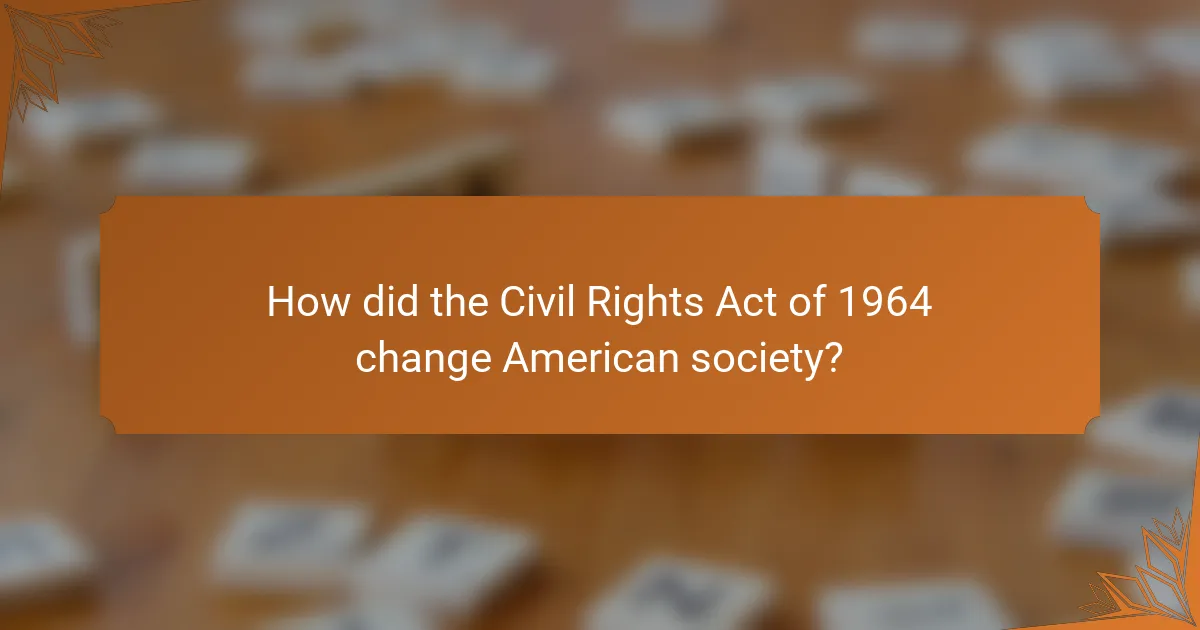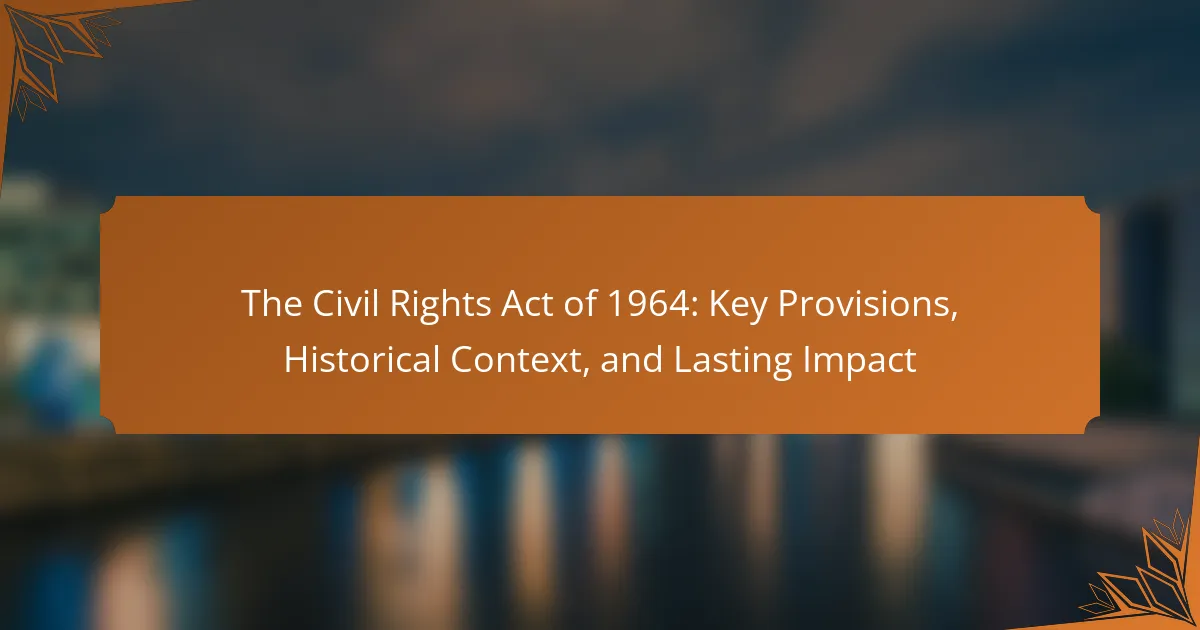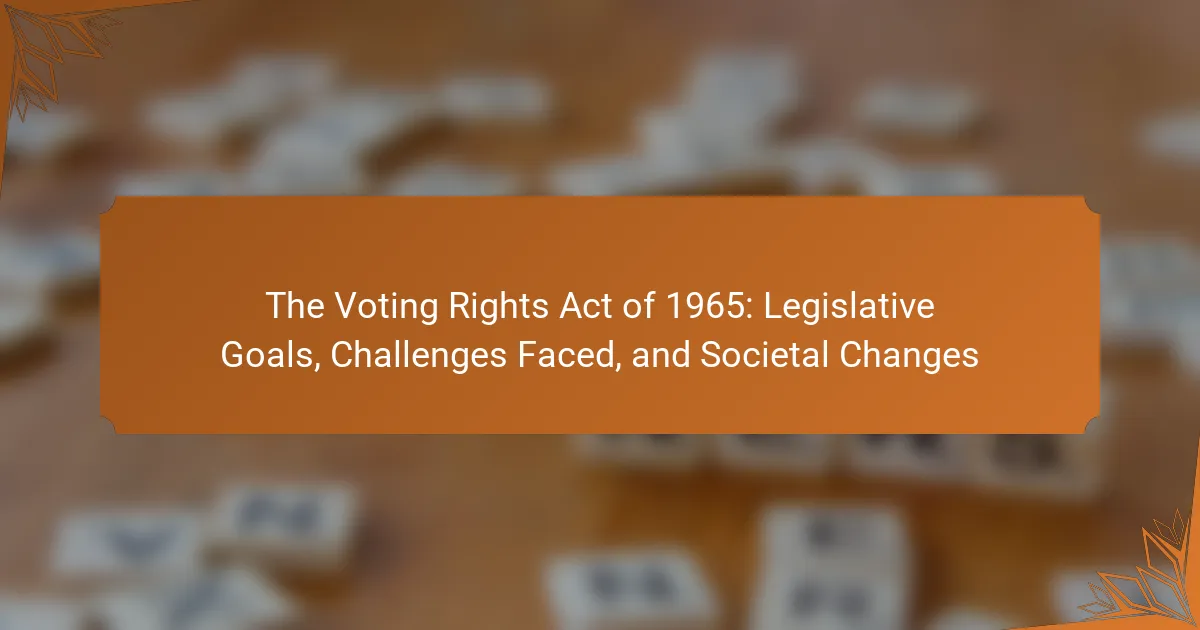The Civil Rights Act of 1964 is a pivotal piece of legislation in the United States that prohibits discrimination based on race, color, religion, sex, or national origin. Signed into law by President Lyndon B. Johnson, it aimed to eliminate segregation in various sectors, including education and employment, and established the Equal Employment Opportunity Commission to enforce compliance. Despite facing significant resistance, particularly in the South, the Act laid the groundwork for future civil rights advancements, influencing subsequent legislation and promoting social change. Its legacy continues to impact civil rights advocacy and awareness of inequality in America today.

What is the Civil Rights Act of 1964?
The Civil Rights Act of 1964 is landmark legislation in the United States that prohibits discrimination based on race, color, religion, [censured], or national origin. This act was signed into law by President Lyndon B. Johnson on July 2, 1964. It aimed to eliminate segregation in schools, workplaces, and public accommodations. The act also enforced the desegregation of public schools and provided for the integration of public facilities. Title VII of the act specifically addresses employment discrimination. It established the Equal Employment Opportunity Commission to oversee compliance. The Civil Rights Act of 1964 is considered a significant achievement of the civil rights movement. Its passage marked a turning point in American history, promoting equality and justice.
Why was the Civil Rights Act of 1964 created?
The Civil Rights Act of 1964 was created to address and eliminate discrimination based on race, color, religion, [censured], or national origin. This landmark legislation aimed to enforce the constitutional right to vote and end segregation in schools and public places. It was a response to the civil rights movement, which highlighted systemic injustices faced by African Americans. The Act also sought to ensure equal employment opportunities and prohibit discriminatory practices in hiring and promotions. Historical events, such as the Birmingham Campaign and the March on Washington, underscored the urgent need for legislative action. The Act’s passage marked a significant turning point in American history, promoting social justice and equality. It laid the groundwork for future civil rights advancements and remains a pivotal achievement in the fight against discrimination.
What social issues prompted the need for the Civil Rights Act of 1964?
The social issues that prompted the need for the Civil Rights Act of 1964 included widespread racial discrimination and segregation. African Americans faced systemic inequalities in education, employment, and housing. Jim Crow laws enforced racial segregation in the Southern United States. Violent incidents, such as the Birmingham campaign and the assassination of civil rights leaders, highlighted the urgent need for change. The Civil Rights Movement sought to end these injustices through peaceful protests and legal challenges. Public support grew for civil rights legislation as awareness of these issues increased. The Act aimed to eliminate discrimination based on race, color, religion, [censured], or national origin. It marked a significant step toward achieving equality and justice for all citizens.
How did the Civil Rights Movement influence the Act?
The Civil Rights Movement significantly influenced the Civil Rights Act of 1964. Activism and protests highlighted the need for legal protections against discrimination. Events like the March on Washington in 1963 garnered national attention. The movement’s efforts pressured lawmakers to address civil rights issues. Key leaders, such as Martin Luther King Jr., advocated for equality and justice. Their speeches and actions mobilized public support for legislative change. The Act aimed to end segregation in schools and public places. It also prohibited employment discrimination based on race, color, religion, [censured], or national origin.
What are the key provisions of the Civil Rights Act of 1964?
The key provisions of the Civil Rights Act of 1964 prohibit discrimination based on race, color, religion, [censured], or national origin. Title I addresses voting rights and aims to eliminate barriers to voting. Title II prohibits discrimination in public accommodations, ensuring equal access to facilities. Title III focuses on desegregation of public facilities. Title IV promotes the desegregation of public schools. Title V expands the powers of the Civil Rights Commission. Title VI prohibits discrimination in federally funded programs. Title VII addresses employment discrimination and establishes the Equal Employment Opportunity Commission. These provisions collectively aim to advance civil rights and ensure equality under the law.
What does Title I of the Civil Rights Act address?
Title I of the Civil Rights Act addresses discrimination in employment. It prohibits employment discrimination based on race, color, religion, [censured], or national origin. This provision aims to ensure equal opportunity in hiring, promotions, and other employment practices. Title I applies to employers with 15 or more employees. It also established the Equal Employment Opportunity Commission (EEOC) to enforce these provisions. The EEOC investigates complaints and can file lawsuits on behalf of individuals. This part of the Act was a significant step toward achieving civil rights in the workplace.
How do Titles II and III impact public accommodations?
Titles II and III of the Civil Rights Act of 1964 significantly impact public accommodations by prohibiting discrimination based on race, color, religion, [censured], or national origin. Title II specifically addresses public accommodations, ensuring that all individuals have equal access to facilities such as hotels, restaurants, and theaters. This title mandates that these establishments cannot refuse service based on discriminatory factors. Title III complements this by focusing on the accessibility of public facilities, requiring them to be available to individuals with disabilities. Together, these titles promote inclusivity and equality in public spaces. Historical enforcement of these titles has led to increased integration in public accommodations across the United States.
What protections are provided under Title VII regarding employment?
Title VII of the Civil Rights Act of 1964 provides protections against employment discrimination. It prohibits discrimination based on race, color, religion, [censured], or national origin. Employers cannot make hiring, firing, or promotion decisions based on these characteristics. Title VII also protects against harassment in the workplace related to these attributes. Furthermore, it prohibits retaliation against individuals who file complaints or participate in investigations under Title VII. The Equal Employment Opportunity Commission (EEOC) enforces these protections. Title VII applies to employers with 15 or more employees. It has been foundational in promoting workplace equality and diversity.
What were the initial reactions to the Civil Rights Act of 1964?
The initial reactions to the Civil Rights Act of 1964 were mixed. Supporters celebrated the act as a significant step toward racial equality. They viewed it as a milestone in the struggle for civil rights. Many civil rights activists praised President Lyndon B. Johnson’s leadership in passing the legislation. Conversely, opponents expressed strong disapproval. Some Southern politicians vehemently opposed the act, fearing it would disrupt the status quo. There were protests and demonstrations against the law in various states. The act faced legal challenges that questioned its constitutionality. Overall, the reactions reflected deep societal divisions regarding race and equality in America.
How did different communities respond to the Act?
Different communities responded to the Civil Rights Act of 1964 with a mix of support and opposition. African American communities largely welcomed the Act as a significant step towards equality. They viewed it as a victory against systemic discrimination. Civil rights organizations, such as the NAACP, actively supported the legislation. They organized campaigns to promote its enforcement.
White Southern communities often opposed the Act. Many resisted integration and civil rights advancements. Some local leaders enacted measures to circumvent the Act’s provisions. This opposition manifested in protests and legal challenges.
Hispanic and Native American communities had varied reactions. Some groups saw the Act as a pathway to improved rights. Others felt that their specific issues were overlooked in the broader civil rights movement.
Overall, the response to the Act reflected the diverse perspectives within American society during the 1960s.
What were the challenges in implementing the Civil Rights Act?

How did the Civil Rights Act of 1964 change American society?
The challenges in implementing the Civil Rights Act of 1964 included widespread resistance in the South. Many local officials opposed desegregation efforts. This resistance often manifested in violence against civil rights activists. Additionally, enforcement mechanisms were initially weak. The federal government struggled to ensure compliance from states. Economic repercussions for non-compliance were not immediately effective. Public opinion was divided, complicating the push for change. Legal battles often delayed the implementation of key provisions. These factors collectively hindered the Act’s immediate impact on American society.
What impact did the Civil Rights Act have on segregation laws?
The Civil Rights Act of 1964 significantly impacted segregation laws in the United States. It outlawed discrimination based on race, color, religion, [censured], or national origin. This legislation aimed to eliminate segregation in schools, workplaces, and public accommodations. Following its enactment, many state and local laws enforcing segregation were rendered unconstitutional. For example, the Act led to the desegregation of public schools across the nation. The federal government gained authority to enforce desegregation, enhancing civil rights protections. Legal challenges against segregation increased, leading to landmark Supreme Court rulings that upheld the Act’s provisions. The Civil Rights Act ultimately transformed the legal landscape regarding segregation in America.
How did the Act affect public education systems?
The Civil Rights Act of 1964 significantly affected public education systems by prohibiting discrimination based on race, color, religion, [censured], or national origin. This legislation mandated the desegregation of schools across the United States. Following its enactment, federal funding for schools became contingent on compliance with desegregation efforts. The Act led to increased enrollment of minority students in previously segregated schools. It also prompted the establishment of guidelines to ensure equitable treatment of all students. Legal cases, such as Brown v. Board of Education, were reinforced by the Act’s provisions. As a result, public education systems underwent substantial reforms to promote inclusivity and diversity. These changes laid the groundwork for ongoing efforts to enhance educational equity.
What changes occurred in employment practices due to the Act?
The Civil Rights Act of 1964 significantly transformed employment practices in the United States. It prohibited employment discrimination based on race, color, religion, [censured], or national origin. This legislation mandated equal opportunity in hiring, promotion, and wages. Employers were required to implement non-discriminatory practices in their workforce. The Act also established the Equal Employment Opportunity Commission (EEOC) to enforce these provisions. The EEOC investigates complaints and can file lawsuits against violators. Consequently, many organizations adopted affirmative action policies to enhance diversity. Overall, the Act fostered a more equitable workplace environment across various industries.
How did the Civil Rights Act influence future legislation?
The Civil Rights Act of 1964 significantly influenced future legislation by establishing a legal framework for combating discrimination. It set precedents for subsequent laws aimed at protecting civil rights. The Act’s provisions against discrimination based on race, color, religion, [censured], or national origin paved the way for similar protections in other contexts. For example, the Fair Housing Act of 1968 built on its principles to address housing discrimination. Additionally, the Act inspired the Americans with Disabilities Act of 1990, which aimed to eliminate discrimination against individuals with disabilities. The Civil Rights Act also encouraged the development of affirmative action policies in education and employment. Its enforcement mechanisms prompted the establishment of the Equal Employment Opportunity Commission (EEOC). Overall, the Civil Rights Act served as a catalyst for a series of legislative efforts to promote equality and protect individual rights in the United States.
What subsequent laws were inspired by the Civil Rights Act?
Subsequent laws inspired by the Civil Rights Act include the Voting Rights Act of 1965. This law aimed to eliminate barriers to voting for African Americans. Another significant law is the Fair Housing Act of 1968. This act prohibited discrimination in housing based on race, color, religion, or national origin. The Equal Employment Opportunity Act of 1972 expanded protections against employment discrimination. Additionally, the Education Amendments of 1972 included Title IX, which prohibits gender discrimination in education. These laws were directly influenced by the principles established in the Civil Rights Act. They collectively aimed to promote equality and protect civil rights in various sectors.
How did the Act pave the way for further civil rights advancements?

What is the lasting legacy of the Civil Rights Act of 1964?
The Civil Rights Act of 1964 paved the way for further civil rights advancements by prohibiting discrimination based on race, color, religion, [censured], or national origin. This landmark legislation established a legal framework for challenging discriminatory practices. It empowered federal agencies to enforce civil rights laws and provided mechanisms for individuals to file complaints. The Act also led to the desegregation of public facilities and schools. Its passage inspired subsequent legislation, such as the Voting Rights Act of 1965. The Civil Rights Act set a precedent for future civil rights movements. It catalyzed social change and heightened awareness of inequality in America. Overall, the Act’s legacy continues to influence civil rights advocacy today.
How is the Civil Rights Act viewed in contemporary society?
The Civil Rights Act is viewed as a foundational legal framework for equality in contemporary society. It is recognized for its role in prohibiting discrimination based on race, color, religion, [censured], or national origin. Many consider it a critical step toward social justice in the United States. Surveys indicate that a significant majority of Americans support the principles established by the Act. For instance, recent polls show that over 70% of respondents believe that the Act’s provisions are essential for protecting civil rights today. The Act’s legacy influences ongoing discussions about racial equality and social justice movements. It is often cited in legal cases and policy debates surrounding discrimination and civil rights. Overall, the Civil Rights Act remains a pivotal reference point in the pursuit of equality and justice in modern society.
What ongoing issues relate to the provisions of the Civil Rights Act?
Ongoing issues related to the provisions of the Civil Rights Act include systemic racism, employment discrimination, and voter suppression. Systemic racism persists in various sectors, affecting access to education and housing. Employment discrimination continues, with studies showing disparities in hiring practices based on race. Voter suppression tactics, such as strict ID laws, disproportionately impact minority communities. Additionally, issues of police brutality and racial profiling remain prevalent. These ongoing challenges demonstrate the need for continued advocacy and policy reform to uphold the Act’s original intent.
How do modern civil rights movements reference the Civil Rights Act?
Modern civil rights movements reference the Civil Rights Act to advocate for equality and justice. They often cite its provisions against discrimination based on race, color, religion, [censured], or national origin. Activists draw parallels between past struggles and current issues like systemic racism and gender inequality. The Act serves as a foundational legal framework for ongoing advocacy efforts. Movements highlight its historical significance in achieving civil rights milestones. They use its legacy to demand enforcement and expansion of protections. Recent protests often invoke the Act to emphasize the need for comprehensive reforms. The Civil Rights Act remains a touchstone for discussions on social justice today.
What lessons can be learned from the Civil Rights Act of 1964?
The Civil Rights Act of 1964 teaches the importance of legislative action in promoting equality. It demonstrates that government intervention can dismantle systemic discrimination. The Act outlawed discrimination based on race, color, religion, [censured], or national origin. This legislation paved the way for future civil rights advancements. It also highlights the necessity of public advocacy in influencing policy change. Grassroots movements played a crucial role in its passage. The Act serves as a reminder of the ongoing struggle for civil rights. Lastly, it illustrates the need for vigilance in protecting those rights against regression.
How can individuals contribute to civil rights today?
Individuals can contribute to civil rights today by actively engaging in advocacy and education. They can participate in local organizations that promote equality and justice. Volunteering for civil rights groups helps amplify their efforts. Educating others about civil rights issues raises awareness in communities. Supporting legislation that protects civil rights is crucial. Individuals can also use social media to share information and mobilize support. Attending peaceful protests demonstrates commitment to civil rights causes. Finally, voting for candidates who prioritize civil rights can lead to systemic change.
What strategies can be used to promote equality in modern society?
Strategies to promote equality in modern society include education, advocacy, and policy reform. Education raises awareness about social injustices and fosters understanding among diverse groups. Advocacy mobilizes communities to support marginalized voices and push for systemic change. Policy reform aims to create laws that protect against discrimination and promote equal opportunities. For instance, implementing affirmative action can help level the playing field in education and employment. Additionally, promoting diversity and inclusion initiatives in workplaces can enhance representation. These strategies are supported by research showing that inclusive environments lead to better social cohesion and economic outcomes.
The Civil Rights Act of 1964 is a landmark legislation in the United States that prohibits discrimination based on race, color, religion, [censured], or national origin. This article provides an overview of the Act’s key provisions, including Titles I through VII, which address voting rights, public accommodations, and employment discrimination, as well as its historical context and the social issues that prompted its creation. It also examines the Civil Rights Movement’s influence on the Act, the initial reactions it received, and its lasting impact on American society, including ongoing challenges related to civil rights and modern advocacy efforts. The article highlights the significance of the Civil Rights Act as a foundational legal framework for promoting equality and justice in the United States.



